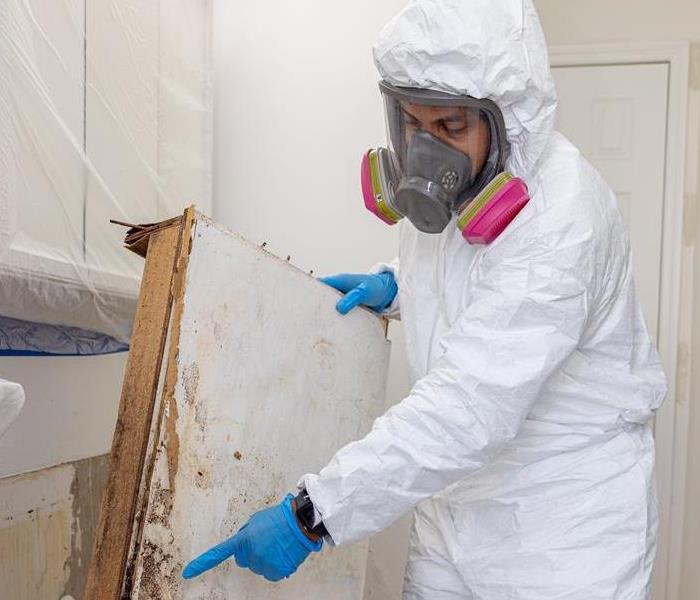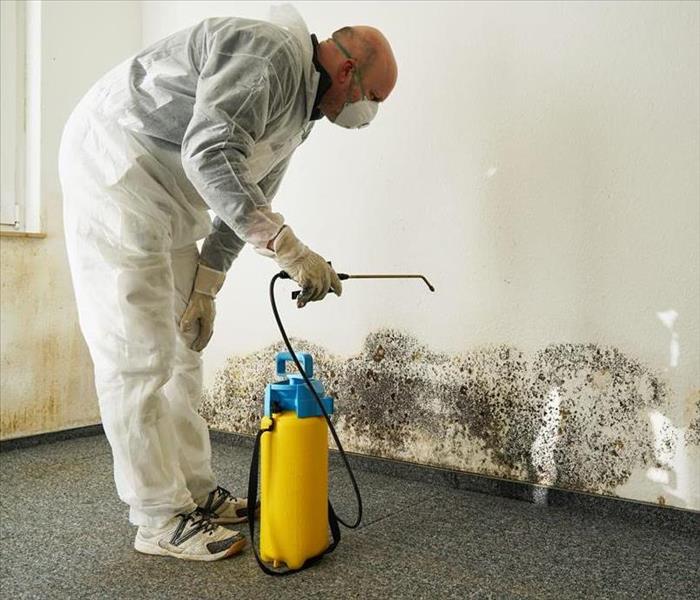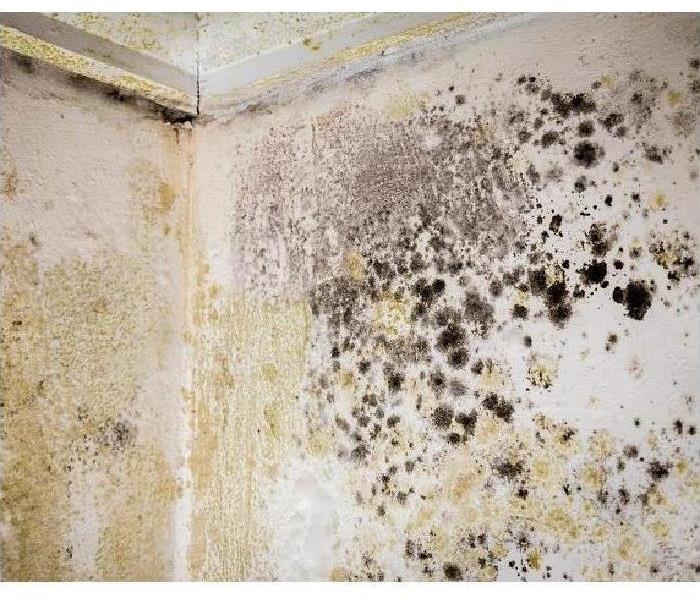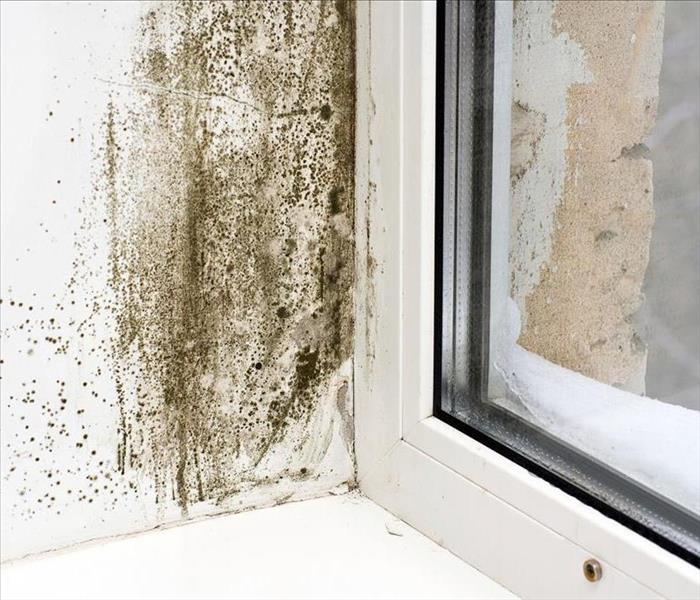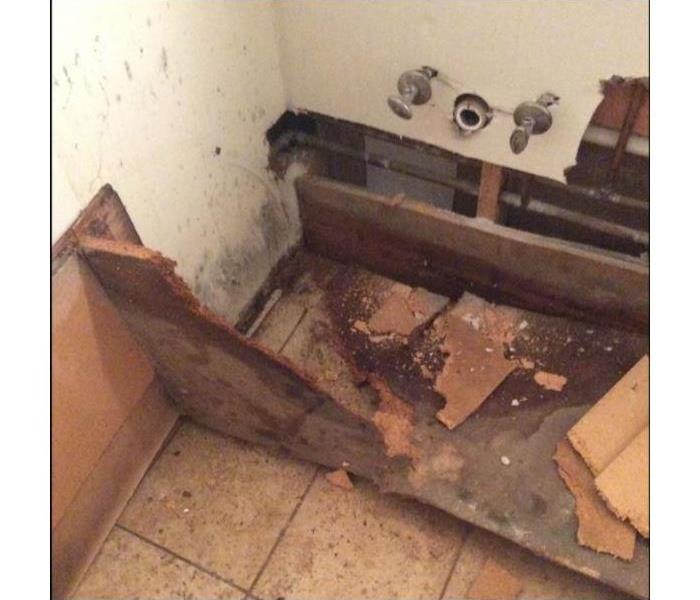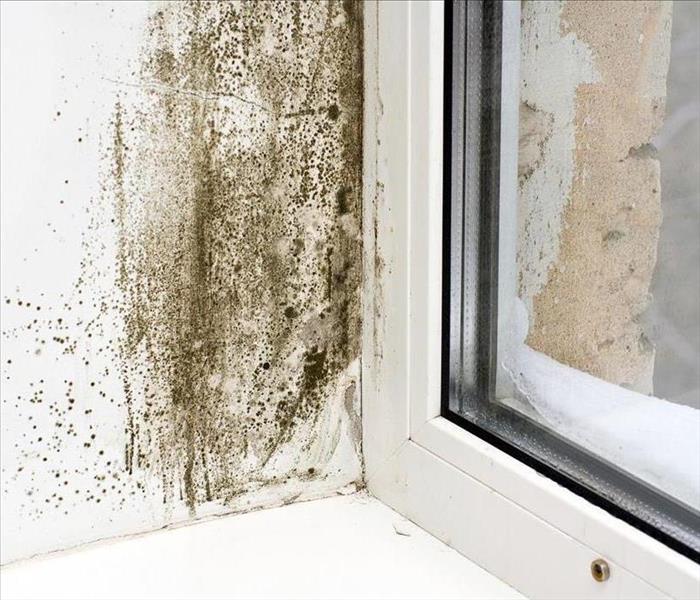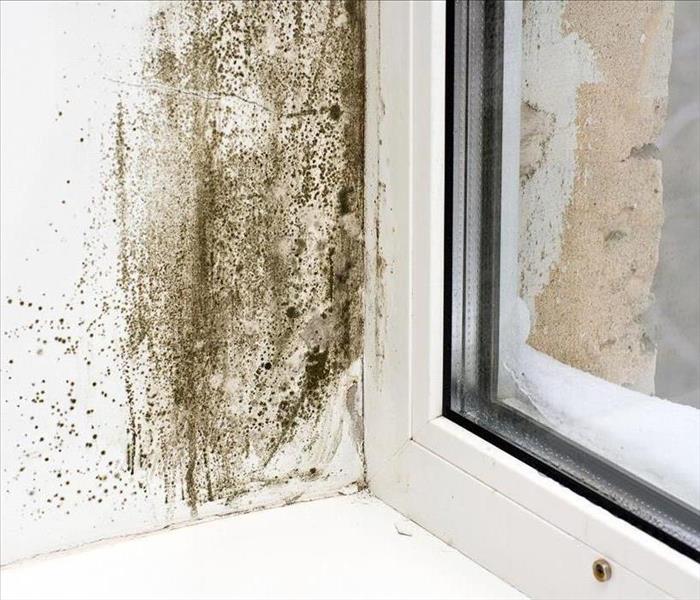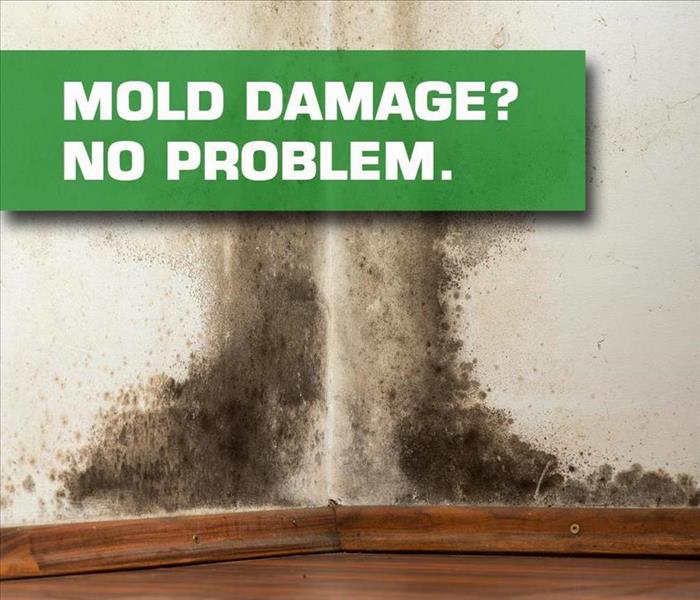Recent Mold Remediation Posts
Mold Remediation: SERVPRO Tackles Hazardous Growth
1/27/2025 (Permalink)
Mold Remediation: SERVPRO of Chesterfield Tackles Hazardous Growth in Homes
Mold can pose serious health risks when it invades homes and businesses. Left unchecked, mold growth can spread rapidly, causing structural damage and potentially triggering allergic reactions or respiratory issues. Professional mold remediation is often necessary to properly address extensive mold problems and restore affected areas to a safe condition.
SERVPRO of Chesterfield specializes in mold remediation services for residential and commercial properties in the Midlothian, Virginia area. Their trained technicians use specialized equipment and proven techniques to identify mold sources, contain the spread, remove contaminated materials, and thoroughly clean and sanitize affected spaces. This comprehensive approach helps eliminate existing mold and prevent future regrowth.
Addressing mold issues promptly is crucial, as even small outbreaks can quickly worsen if left untreated. SERVPRO of Chesterfield offers 24/7 emergency response to begin the remediation process as soon as possible. Their experts can assess the full extent of mold damage and develop an effective remediation plan tailored to each unique situation.
Understanding Mold and Its Hazards
Mold is a type of fungus that thrives in damp environments. It can grow indoors and outdoors, potentially causing structural damage and health issues.
Types of Mold Commonly Found in Buildings
Aspergillus is a common indoor mold. It can appear in various colors including green, gray, and white. Aspergillus often grows on damp walls, ceilings, and fabrics.
Penicillium is another prevalent mold species. It typically has a blue or green color and a fuzzy texture. This mold frequently develops on water-damaged materials like carpets and wallpaper.
Stachybotrys, often called "black mold," is less common but more notorious. It has a dark green or black color and grows on materials with high cellulose content, such as drywall or wood, that have been exposed to prolonged moisture.
Health Risks Associated with Mold Exposure
Mold exposure can trigger allergic reactions in sensitive individuals. Symptoms may include sneezing, runny nose, red eyes, and skin rash. These reactions can range from mild to severe.
Respiratory issues are another concern. Mold spores can irritate the lungs, potentially causing coughing, wheezing, and difficulty breathing. People with asthma or other respiratory conditions may experience more severe reactions.
In some cases, mold exposure can lead to more serious health problems. Prolonged exposure to certain molds may cause chronic sinus infections, lung infections, or other respiratory diseases. Individuals with weakened immune systems are particularly vulnerable to these risks.
Mold Remediation Process
Effective mold remediation involves a systematic approach to identify, contain, and eliminate mold growth. The process requires specialized equipment and expertise to ensure thorough removal and prevent future recurrence.
Initial Assessment and Inspection
Professionals begin by conducting a thorough inspection of the affected area. They use moisture meters and thermal imaging cameras to detect hidden moisture sources. Visual examination helps identify visible mold growth and potential problem areas.
Air and surface samples may be collected to determine the types and concentrations of mold present. This information guides the development of an appropriate remediation plan.
The extent of the mold damage is documented, including affected materials and square footage. This assessment forms the basis for developing a tailored remediation strategy.
Containment and Air Filtration
Containment is crucial to prevent mold spores from spreading to unaffected areas. Plastic sheeting is used to seal off the contaminated space. Negative air pressure is established within the containment area.
HEPA air scrubbers are deployed to filter the air and capture airborne mold spores. This helps improve air quality and reduce the risk of cross-contamination.
Dehumidifiers are used to lower humidity levels, creating an environment less conducive to mold growth. Proper ventilation is maintained throughout the remediation process.
Removing Mold and Infested Materials
Non-porous surfaces with mold growth are cleaned using specialized antimicrobial solutions. HEPA vacuums are employed to remove loose mold spores from surfaces.
Porous materials that cannot be adequately cleaned, such as drywall or carpeting, are removed and disposed of safely. Proper containment and handling procedures are followed to minimize spore dispersal.
Structural elements like wood framing may require sanding or other abrasive methods to remove mold growth. These processes are performed with care to avoid damaging the underlying structure.
Cleaning, Sanitizing, and Preventing Future Growth
All salvageable items and surfaces are thoroughly cleaned and disinfected. HEPA vacuuming is performed again to remove any residual spores or debris.
Antimicrobial treatments are applied to surfaces to inhibit future mold growth. Areas of previous moisture intrusion are addressed to prevent recurrence.
The space is dried completely using industrial-grade dehumidifiers and air movers. Proper humidity levels are maintained to discourage mold growth.
Education is provided on moisture control and proper ventilation to prevent future mold issues. Regular inspections and maintenance are recommended to catch potential problems early.
SERVPRO of Chesterfield's Approach to Mold Remediation
SERVPRO of Chesterfield employs a comprehensive strategy for mold remediation. Their approach combines professional expertise, advanced techniques, and a focus on customer service to effectively address mold issues in homes and businesses.
Professional Standards and Certification
SERVPRO of Chesterfield maintains high professional standards in mold remediation. Their staff undergoes rigorous training to stay current with industry best practices. Technicians are certified in mold remediation techniques, ensuring they can handle various mold situations safely and effectively.
The company adheres to strict protocols established by industry organizations. This includes following proper containment procedures to prevent mold spores from spreading during the remediation process. SERVPRO's team uses personal protective equipment to safeguard their health and maintain a sterile work environment.
Regular audits and quality checks help maintain consistency in their service delivery. This commitment to professionalism gives clients confidence in SERVPRO's ability to tackle even complex mold problems.
Advanced Remediation Techniques and Equipment
SERVPRO of Chesterfield utilizes state-of-the-art equipment and cutting-edge techniques for mold remediation. Their arsenal includes specialized air scrubbers and HEPA vacuums to filter mold spores from the air. Moisture meters and infrared cameras help identify hidden water sources that may contribute to mold growth.
The company employs both chemical and physical remediation methods. This may involve applying antimicrobial agents to prevent future mold growth or using dry ice blasting to remove mold from surfaces without damaging the underlying material.
SERVPRO's approach is tailored to each specific situation. They assess the extent of mold damage and develop a customized plan that may include removal of affected materials, cleaning, and restoration of the area to its pre-mold condition.
Customer Communication and Service
Clear communication is a cornerstone of SERVPRO of Chesterfield's mold remediation process. They prioritize keeping clients informed at every stage of the remediation. This begins with a thorough explanation of the mold problem and the proposed remediation plan.
Technicians provide regular updates on the progress of the work. They explain any unexpected issues that arise and discuss potential solutions with the client. This transparent approach helps build trust and ensures clients understand the remediation process.
SERVPRO offers 24/7 emergency response for mold issues. Their team works efficiently to minimize disruption to the client's daily life or business operations. After completing the remediation, they conduct a final walkthrough with the client to ensure satisfaction with the results.
Post-Remediation Recommendations
Proper follow-up actions are crucial after mold remediation to ensure a safe and healthy environment. These steps focus on repairing damage, monitoring for potential regrowth, and implementing strategies to prevent future mold issues.
Structural Repairs and Restoration
After mold removal, affected areas often require repairs. Replace damaged drywall, insulation, and other porous materials. Repaint surfaces with mold-resistant paint to inhibit future growth.
Repair any leaks or water damage that contributed to the initial mold problem. This may involve fixing plumbing issues, roof leaks, or improving drainage around the foundation.
Thoroughly clean and disinfect the remediated area. Use HEPA vacuums to remove any remaining spores or debris. Consider professional cleaning of carpets, upholstery, and HVAC systems to eliminate lingering mold spores.
Monitoring for Recurrence
Regular inspections are essential to catch any early signs of mold regrowth. Check remediated areas monthly for the first few months, then quarterly thereafter.
Use moisture meters to detect hidden dampness in walls, floors, and ceilings. Address any elevated moisture levels promptly to prevent mold from returning.
Consider periodic air quality testing to ensure mold spore levels remain low. Professional testing can provide peace of mind and early detection of potential issues.
Keep detailed records of inspections and any observed changes. This documentation can be valuable for identifying patterns or addressing future concerns.
Long-Term Prevention Strategies
Maintain indoor humidity levels between 30-50% using dehumidifiers or air conditioners. Install humidity monitors in prone areas like basements and bathrooms.
Improve ventilation throughout the building. Use exhaust fans in bathrooms and kitchens. Ensure proper attic ventilation to prevent moisture buildup.
Address any ongoing water intrusion issues. Maintain gutters and downspouts, grade soil away from the foundation, and seal any cracks in the building envelope.
Use mold-resistant products for future renovations or repairs. These include mold-resistant drywall, paints, and building materials designed to inhibit mold growth.
Educate occupants on mold prevention strategies. Encourage prompt reporting of water leaks or signs of moisture. Implement a regular cleaning schedule, focusing on areas prone to mold growth.
Regulations and Guidelines for Safe Mold Remediation
Proper mold remediation requires adherence to established standards and protocols. Federal agencies have developed comprehensive guidelines to ensure safe and effective mold removal practices.
Environmental Protection Agency (EPA) Standards
The EPA provides key recommendations for mold remediation in buildings. For small areas under 10 square feet, basic cleaning with water and detergent is often sufficient. Larger contaminated areas require more extensive procedures.
EPA guidelines emphasize:
- Addressing moisture sources before remediation
- Using proper personal protective equipment (PPE)
- Containing work areas to prevent spore spread
- Thorough cleaning and drying of affected materials
The agency advises hiring experienced professionals for large-scale remediation projects, especially those exceeding 100 square feet.
Occupational Safety and Health Administration (OSHA) Guidelines
OSHA focuses on protecting workers involved in mold remediation activities. The agency's standards cover respiratory protection, PPE, and hazard communication.
Key OSHA recommendations include:
- Conducting a hazard assessment before remediation
- Using appropriate respirators based on contamination levels
- Providing worker training on mold hazards and safe practices
- Implementing proper containment and ventilation measures
OSHA also emphasizes the importance of addressing any underlying moisture issues to prevent future mold growth. Regular inspections and prompt repairs are essential for maintaining a mold-free environment.
Mold Remediation: Effective Strategies for a Healthy Home
12/13/2024 (Permalink)
Mold can pose serious health risks and damage to homes, making prompt remediation essential. Mold remediation effectively removes mold and restores areas to a safe and healthy state, preventing future growth and health hazards. Understanding the process of mold remediation helps homeowners make informed decisions about when to hire professionals and how to manage minor mold issues themselves.
The process typically involves identifying the source of moisture, containing the affected areas, removing contaminated materials, and applying treatments to eliminate remaining spores. By following proper procedures and safety measures, mold can be dealt with effectively and responsibly.
Awareness of the signs of mold and the importance of timely action can save homeowners from extensive damage and costly repairs. This article will explore the key steps involved in mold remediation and offer practical tips for maintaining a mold-free environment.
Understanding Mold
Mold is a type of fungus that thrives in various environments, often posing risks to health and property. A comprehensive look at its types, health implications, and growth conditions is essential for effective management.
Types of Mold
Mold exists in numerous species, each with unique characteristics. Common types include:
· Aspergillus: Often found in soil and decaying matter, it can produce toxins harmful to humans.
· Penicillium: Recognized for its role in antibiotic production, this mold can also cause allergies and respiratory issues.
· Stachybotrys chartarum: Known as black mold, it is notorious for its association with severe health problems, particularly in damp environments.
Each type can have distinct appearances ranging from green to black and fuzzy to slimy. Identifying specific mold types aids in determining appropriate remediation strategies.
Health Implications
Exposure to mold can lead to various health issues, especially for sensitive individuals, such as those with asthma or compromised immune systems. Symptoms may include:
· Respiratory issues: Coughing, sneezing, and difficulty breathing.
· Allergic reactions: Itchy eyes, skin rashes, and sinus congestion.
· Severe responses: In more serious cases, exposure to certain molds can result in long-term health effects, including lung infections.
People should be aware of these risks, particularly in homes or buildings where mold growth is prevalent. Addressing mold issues promptly can mitigate health risks effectively.
Mold Growth Conditions
Mold requires specific conditions to grow, primarily moisture. Key factors include:
· Humidity: High humidity levels (above 60%) provide an ideal environment for mold.
· Materials: Organic materials, such as wood, drywall, and textiles, are conducive to mold growth.
· Temperature: Mold thrives in warm environments, typically between 77°F and 86°F (25°C and 30°C).
Preventive measures should focus on controlling these conditions. Regular inspections and proper ventilation are critical to maintaining a mold-free environment.
Assessment Procedures
Effective mold remediation begins with thorough assessment procedures. These steps include various inspection techniques, mold sampling methods, and determining the extent of mold presence. Each step plays a critical role in understanding the mold problem and formulating an effective remediation plan.
Inspection Techniques
Inspection techniques are fundamental to identifying mold presence and moisture sources. Trained professionals visually inspect various areas, focusing on high-risk environments like basements, bathrooms, and around plumbing fixtures.
Tools such as moisture meters and thermal imaging cameras can enhance detection. Moisture meters measure the levels of dampness, while thermal cameras identify temperature variations, often indicating hidden mold.
Moreover, professionals consider the building structure and materials. Porous materials, such as drywall and wood, are particularly susceptible to mold growth. A comprehensive visual assessment takes these factors into account.
Mold Sampling
Mold sampling involves collecting samples to identify the type of mold present. Techniques include air sampling, surface sampling, and bulk sampling.
Air sampling captures airborne mold spores, providing insight into mold levels within indoor air. Surface sampling, done with swabs or tape, involves taking samples from surfaces where mold is suspected. Bulk sampling collects material suspected of harboring mold for analysis.
Samples are analyzed in labs to identify mold species and concentrations. Knowing the specific types of mold helps determine health risks and appropriate remediation methods.
Determining Mold Extent
Determining the extent of mold growth is crucial for developing a remediation strategy. This process involves assessing not just visible mold but also hidden infestations.
Professionals may employ invasive techniques, such as cutting into materials, to check for deeper mold growth. In some cases, behind walls or under flooring may hide substantial mold colonies.
Additionally, evaluating the duration of moisture presence helps quantify the severity of mold growth. Using tools like moisture meters and visual evidence, a comprehensive map of affected areas can be created, guiding effective remediation.
Remediation Strategies
Effective mold remediation requires a structured approach to minimize health risks and property damage. This section outlines key strategies, focusing on containment, mold removal, and proper handling of materials.
Containment and Ventilation
Containment is essential to prevent mold spores from spreading during the remediation process. Establishment of physical barriers using plastic sheeting can help isolate affected areas. This includes sealing off doors, vents, and windows to prevent cross-contamination.
Proper ventilation is equally critical. During remediation, using negative air pressure machines can expel contaminated air, ensuring cleaner air circulation. Workers should wear appropriate personal protective equipment (PPE) such as N95 respirators and protective clothing to minimize exposure.
Employing air filters can further improve air quality. Combination of HEPA filters and air purifiers assists in capturing airborne spores, enhancing safety during the process.
Mold Removal Methods
Mold removal methods vary based on the level of contamination. Thorough cleaning is crucial for minor infestations. This may involve scrubbing surfaces with detergent solutions or using specialized cleaners designed for mold.
For more significant growth, physical removal of contaminated materials is often necessary. Materials such as drywall, carpeting, or insulation may need complete replacement if they are heavily infested.
In addition, antifungal treatments can be applied to surfaces post-cleaning to prevent future growth. It’s important to follow manufacturer guidelines for these products to ensure effective results.
Materials Handling and Disposal
Handling contaminated materials requires caution. Proper disposal methods help prevent the spread of mold. All removed materials must be sealed in heavy-duty plastic bags before being transported.
Local regulations on hazardous waste can dictate specific disposal options. It’s advisable for professionals to check local guidelines before proceeding.
In some cases, items may be salvaged after thorough cleaning and drying. However, porous materials often require disposal due to their inability to be effectively cleaned. Ensuring proper documentation of removed materials can assist in maintaining compliance with regulations.
Prevention and Control
Effective prevention and control strategies are essential for reducing mold growth in indoor environments. Key practices focus on managing moisture levels and making informed building design choices.
Moisture Control
Controlling moisture is vital in preventing mold growth. Mold spores require a damp environment to thrive, so keeping humidity levels below 60% can significantly reduce the risk.
Practical measures include:
· Using dehumidifiers in basements and crawl spaces.
· Ventilating areas prone to moisture, such as bathrooms and kitchens, by using exhaust fans.
· Fixing leaks promptly to prevent water accumulation in walls or ceilings.
· Sealing windows and doors to prevent moisture infiltration.
Regularly inspecting areas for condensation and water damage is also crucial. If mold is detected, it should be addressed immediately to prevent further spread.
Building and Design Factors
Building design plays a key role in mold prevention. Structures should incorporate materials and layouts that minimize moisture accumulation.
Considerations include:
· Using mold-resistant materials, such as drywall and paint, particularly in moisture-prone areas.
· Designing proper drainage systems around the foundation to divert water away from the building.
· Implementing adequate insulation to prevent condensation on cold surfaces.
Proper ventilation in attics and crawl spaces helps ensure air circulation, further limiting moisture build-up.
Incorporating these design aspects can create a resilient barrier against mold, ensuring a healthier indoor environment.
Restoration and Repair
Restoration and repair are crucial steps in the mold remediation process. These actions not only address existing damage but also ensure that affected areas are safe and livable once again.
Structural Repairs
Structural repairs may involve replacing damaged materials like drywall, insulation, or flooring. When mold has compromised these elements, they must be removed to prevent further growth and structural instability.
Professionals evaluate the extent of the damage and proceed with appropriate repairs. This could include:
· Drying out: Ensuring all affected areas are completely dry.
· Reconstruction: Installing new drywall or flooring, depending on what was damaged.
Hiring experts in restoration ensures that repairs meet local building codes and guarantees a safe environment. They also offer advice on preventing future mold exposure.
Finishing Touches
Once structural repairs are complete, finishing touches are essential for restoring the aesthetics of a space. This stage often includes painting and installing fixtures.
Attention to detail in this phase includes:
· Painting: Using mold-resistant paint to protect surfaces.
· Cleanliness: Ensuring all areas are spotless and free from contaminants.
Professionals often recommend using high-quality materials that withstand moisture. This helps maintain the integrity of the repair work and reduces the likelihood of mold returning. Engaging with experts ensures a thorough approach to both functional and aesthetics.
Mold Myths
8/10/2020 (Permalink)
A lot of people have some misconceptions about mold and mold growth. To the untrained and under-educated eye, mold can either be extremely scary or nothing to worry about at all. Here we will help you try and understand the myths and facts about mold, because it's important to grasp the full extent of this mysterious growth. These are some common myths about mold:
- Mold Can be Completely Erased - this is completely untrue because mold spores are naturally in our environment. There will always be some type of mold in your home but this is usually within the normal level - it begins to become an issue when it grows in large, visible colonies.
- "Black Mold" is the Most Dangerous Kind - this is mostly untrue because most mold that looks black is actually dark green and do not carry the Stachybotrys mold that can inflict health affects.
- Mold Remediation is Easily Handled Yourself - usually untrue unless your are dealing with a very small area in your bathroom for example. However, it is always recommended to call the professionals at SERVPRO of Chesterfield and SERVPRO of Tri-Cities Plus to handle mold concerns.
- Bleach Kills All Mold - this is not always true. Bleach may be able to kill certain types of mold, but only on nonporous surfaces. But mold on other materials such as wood is more complicated and not so straightforward.
- Mold Only Grows After Water Damage - this is not always true. Yes mold can grow is a water damaged area is not addressed right away. However, spores will grow without water and when humidity levels are high in a structure that is not kept dry and cool.
Call the professionals at SERVPRO of Chesterfield and SERVPRO of Tri-Cities Plus if you have mold issues in your home or business. 804-378-2323
Tips To Prevent Mold In Your Home
7/22/2020 (Permalink)
During the hotter months, mold is more likely to show up and thrive in these hot temperatures. It's important to notes these tips so you're not dealing with mold growth in your home.
- Always use your air conditioner on days that reach up to 77 degrees
- if some rooms in your home tend to have a high humidity rate, purchase a dehumidifier to reduce the moisture in the room
- Keep an eye out for moisture or condensation on your air ducts
- Make sure windows and doors are completely closed when it rains to prevent water from soaking in the floors and windowsills
- Check for leaks in your roof to prevent mold growth from sitting water
Contact SERVPRO of Chesterfield and SERVPRO of Tri-Cities Plus if you see signs of mold in your home. 804.378.2323.
Understanding Mold Remediation Process
7/20/2020 (Permalink)
At SERVPRO of Chesterfield and SERVPRO of Tri-Cities Plus, we understand mold. We understand what causes mold, what necessary steps to take, the right equipment to use, and of course, the prevention of future mold growth.
These steps listed below describe our process and the best practices when it comes to mold remediation.
- Contact SERVPRO of Chesterfield and SERVPRO of Tri-Cities Plus Immediately
The mold cleanup and restoration process begins when you call us. Our representative will ask a series of questions to help us determine the necessary equipment, resources, and personnel.
- Inspection and Mold Damage Assessment
We carefully inspect your property for visible signs of mold. Mold feeds on cellulose and water and can be hidden from plain view. We use various technologies to detect mold and hidden water sources.
- Mold Containment
Our professionals use various containment procedures to prevent the spread of mold. We may use advanced containment procedures like negative air chambers to isolate the contaminated area with physical barriers and negative air pressure to keep the mold spores from spreading during the cleanup process. All fans and heating and cooling systems will be turned off to prevent the spread of mold.
- Air Filtration
Our specialized filtration equipment allows our Professionals to capture microscopic mold spores out of the air. We utilize powerful “air scrubbers” and HEPA vacuums to prevent the spread of these mold spores while the mold remediation is in process.
- Removing Mold and Mold-Infested Materials
The mold remediation process depends on the amount of mold growth and the types of surfaces on which the mold appears. We’ll use antifungal and antimicrobial treatments to eliminate mold colonies and to help prevent new colonies from forming. It may be necessary to remove and dispose of mold-infested porous materials, like drywall and carpeting, to remediate heavy mold growth.
- Cleaning Contents and Belongings
We clean your furniture, decorative items, curtains, clothing, and other restorable items affected by mold. We use a variety of cleaning techniques to clean and disinfect your belongings. We’re also trained to remove odors and deodorization using fogging equipment.
- Restoration
Depending on the level of mold damage, drywall, subfloors, and other building materials may have been removed. Restoration may involve minor repairs, such as replacing drywall, painting, and installing new carpet; or it may entail major repairs such as the reconstruction of various areas or rooms in a home or business. The restoration step gets your home or business back to normal.
Got Mold?
8/12/2019 (Permalink)
The Truth is, It's Everywhere
Let’s face it, mold is everywhere. It can be found indoors and outdoors. It can enter your home or business through windows, vents and HVAC systems. Mold from outdoors can attach to clothing, shoes, pets and can be carried indoors. It grows anywhere, especially where there is moisture. And the worst part is, it can cause a variety of health effects. Children, the elderly, and anyone with respiratory problems are more likely to suffer the effects mold can have.
Mold’s Best Friend:
Water. Any home or business can quickly become infested with mold with the introduction of a water source, like a roof or plumbing leak. Mold can spread throughout a property in as little as 48-72 hours
Consider the following mold facts:
- Mold is present almost everywhere, indoors and outdoors.
- Mold spores are microscopic, float along in the air, and may enter your home through windows, doors, or AC/heating systems or even hitch a ride indoors on your clothing or a pet.
- Mold spores thrive on moisture. Mold spores can quickly grow into colonies when exposed to water. These colonies may produce allergens and irritants and have the potential to cause other health effects.
- Before mold remediation can begin, any sources of water or moisture must be addressed. Otherwise, the mold may return.
- Mold often produces a strong, musty odor, and that odor can lead you to possible mold problem areas.
- Even higher-than-normal indoor humidity can support mold growth. Keep indoor humidity below 45 percent.
“Mold Removal” vs. Remediation
Because mold is everywhere, removing all mold from your home or business is impossible. A qualified restoration company understand the science behind mold and mold growth and knows how to remediate the problem area. So what do you do when you find mold growth in your home or business?
- Step 1: Contact SERVPRO of Chesterfield and SERVPRO of Tri-Cities Plus at 804.378.2323
- Step 2: Inspection and Mold Damage Assessment
- Step 3: Mold Containment
- Step 4: Air Filtration
- Step 5: Removing Mold and Mold-Infested Materials
- Step 6: Cleaning Contents and Belongings
- Step 7: Restoration
Managing Mold in Chesterfield
7/23/2019 (Permalink)
Molds are found in every environment, and mold spores reproduce rapidly when moisture is present.
SERVPRO of Chesterfield and SERVPRO of Tri-Cities Plus professionals handle water damages every day and know prompt action is required to prevent mold growth, if there is an ongoing moisture problem in the building, be alert for:
- The presence of visible mold
- Strong, musty odors, which may indicate mold is present
- Any evidence of past moisture problems that might have caused undetected mold growth
- Excessive humidity.
These conditions may require the expertise of a qualified Indoor Air Quality/Environmental Professional to inspect the building for mold growth and water damage problems.
SERVPRO of Chesterfield and SERVPRO of Tri-Cities Plus cares about proper restoration of your structure and, in most water damage situations, can safely restore your building to preloss condition.
Mold Removal vs. Mold Remediation
6/20/2018 (Permalink)
SERVPRO of Chesterfield has been remediating mold in homes and businesses for over 30 years. Since microscopic mold spores exist naturally almost everywhere, indoors and outdoors, removing all mold from a home or business is impossible. Many restoration businesses advertise “mold removal” and even guarantee to remove all mold. This is a fallacy. We understand mold and mold growth. SERVPRO of Chesterfield has the training and expertise to remediate the mold in your home or business.
It is important, especially after a water damage, to quickly address any signs of mold in the home or business. If there is moisture present, growth can start in as little as 48 hours. If not addressed in a timely manner, mold spores can quickly grow into colonies when exposed to water. These colonies may produce allergens and irritants. Mold can also produce a strong, musty odor, and that odor can lead you to possible mold problem areas.
If you discover mold in your home, don’t hesitate to call the professionals who will abide by a remediation process:
- Contact - (804) 378-2323
- Inspection and Mold Damage Assessment
- Mold Containment
- Air Filtration
- Removing Mold and Mold-Infested Materials
- Cleaning Contents and Belongings
Commercial Mold Damage
6/20/2018 (Permalink)
Besides causing a major business interruption, a mold problem can present a serious health risk for people exposed at your commercial property.
Mold infestations can be caused by minor water intrusions, like a slow roof leak or loose plumbing fitting. Every hour spent cleaning up is an hour of lost revenue and productivity. If you suspect your property has a mold problem, call SERVPRO of Chesterfield, who will respond quickly and work fast to manage the situation.
Mold can spread quickly through a property if left untreated. SERVPRO of Chesterfield can respond quickly, working to first contain the infestation to help prevent its spread to other parts of the building. Next, we will begin the remediation process, working safely and effectively to manage the situation. We have the training, experience, and equipment to contain the mold infestation and remediate it to preloss condition.
Moisture Control is Key to Mold Control
6/4/2018 (Permalink)
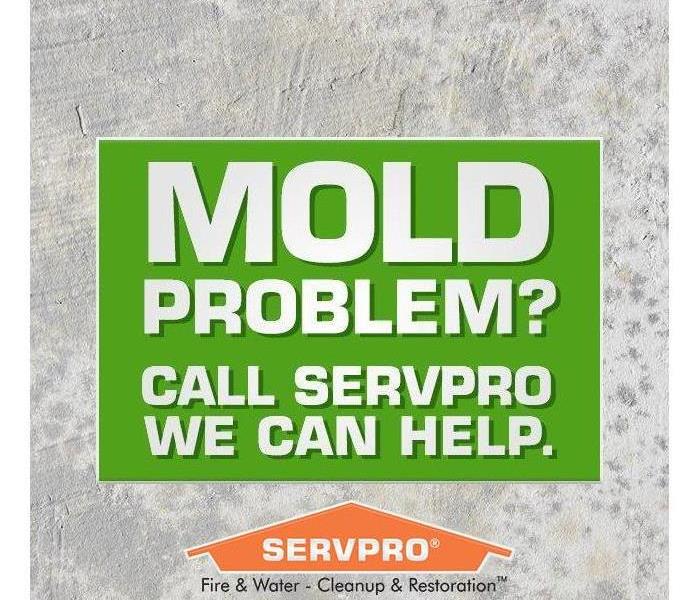
- Keep humidity levels as low as you can—no higher than 50%--all day long. An air conditioner or dehumidifier will help you keep the level low. Humidity levels change throughout the day as changes occur in the moisture in the air and the air temperature, so check the humidity levels more than once a day.
- If you see condensation or moisture collecting on windows, walls or pipes ACT QUICKLY to dry the wet surface and reduce the moisture/water source. Condensation can be a sign of high humidity.
- Be sure your home has enough ventilation. Use exhaust fans, which vent outside your home in the kitchen and bathroom. Make sure your clothes dryer vents outside your home.
- Fix any leaks in your home’s roof, walls, or plumbing so mold does not have moisture to grow.
- Clean up and dry out your home thoroughly and quickly (within 24–48 hours) after flooding.
- Remove or replace carpets and upholstery that have been soaked and cannot be dried promptly. Consider not using carpet in rooms or areas like bathrooms or basements that may have a lot of moisture.






 24/7 Emergency Service
24/7 Emergency Service
